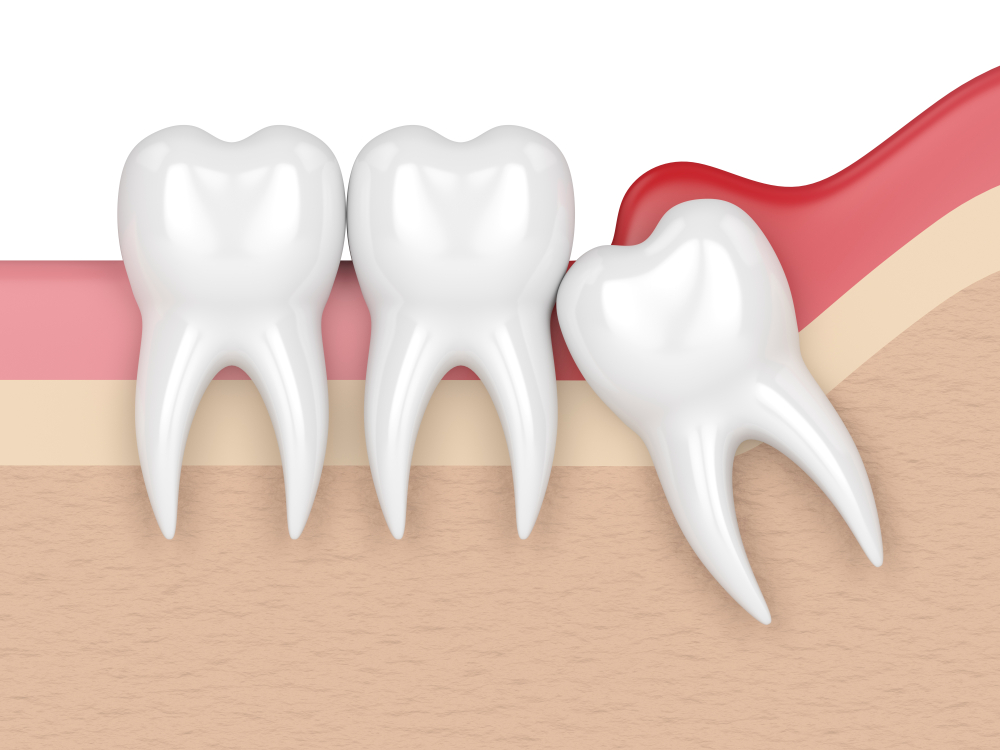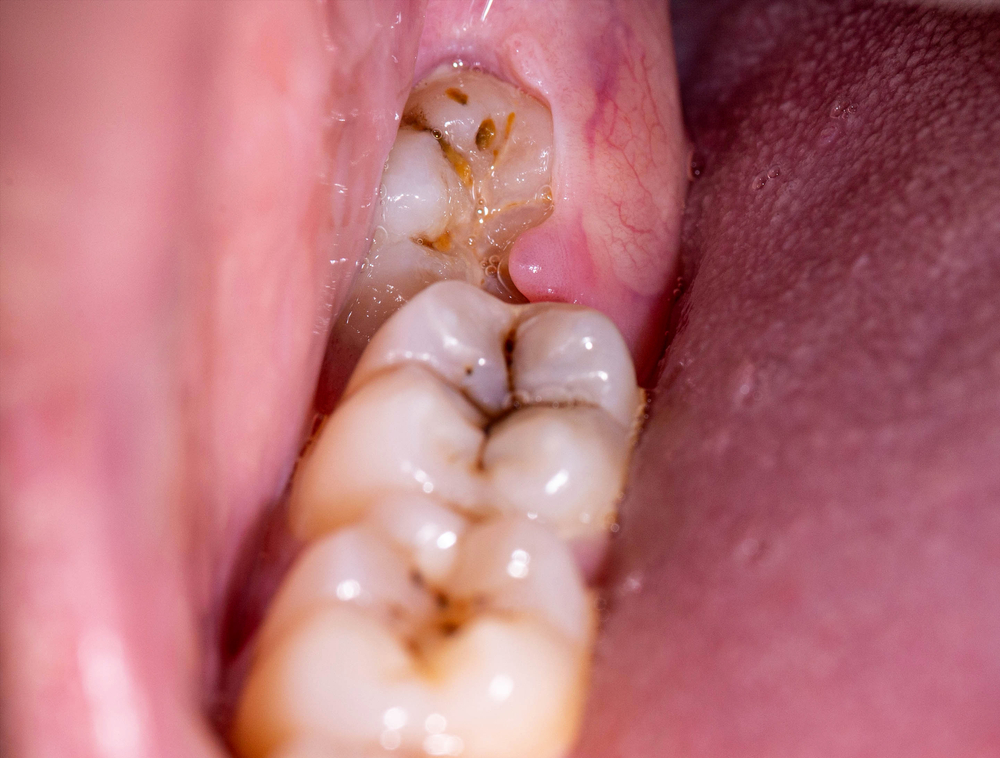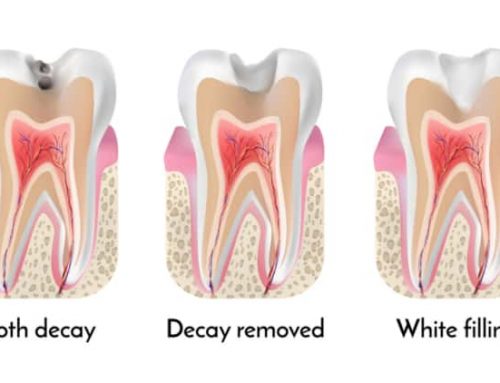Pericoronitis is the inflammation, swelling and infection of the gum tissue surrounding the wisdom teeth, which are located as the third and final set of molars that usually appear in your late teens or early 20s. It is most commonly found around the lower wisdom teeth.
What causes pericoronitis?
The primary cause for pericoronitis is accumulation of bacteria in and surrounding the gum tissue. Usually, the tooth is only partially exposed (soft tissue impaction) and has excess gum tissue that overlaps the tooth. Bacteria and food debris get trapped in the space between the tooth and the overlapping gingiva.

What Does Pericoronitis Look Like?
If you have inflamed, red, or swollen gums surrounding your wisdom teeth that may or may not be draining pus, then you may have pericoronitis. For proper diagnosis of pericoronitis, you should visit the dentist and the dentist will exam the wisdom teeth and check for signs of and the appearance of pericoronitis.
The top 5 pericoronitis symptoms are:
- Inflamed Gums
- Red Gum Tissue
- Swollen Gum Tissue
- A Gum Flap
- Draining Pus

Does pericoronitis go away on its own?
Unfortunately, pericoronitis won’t go away on its own. If it goes untreated, it can become dangerous after only a couple of weeks. Typically, either the flap of tissue or the wisdom tooth needs to be removed. If an infection is present, an antibiotic will be needed, as well. By properly caring for your gums and having the wisdom tooth removed you can easily fix and recover fully from pericoronitis.
Can you get rid of pericoronitis at home?
While you can treat pericoronitis if it hasn’t progressed to far from home, it’s best to have an examination and treatment from your dentist to fully recover from pericoronitis before it gets out of hand. Home remedies for pericoronitis include:
- over-the-counter pain relievers;
- warm salt-water rinses;
- oral water irrigators;
- good oral hygiene, including brushing and flossing.
Is pericoronitis contagious?
While sharing food and drinks or kissing can transmit “bad” bacteria to your mouth that contribute to gum disease, gum disease on its’ own is not contagious.
How Long Does Pericoronitis Last?
Symptoms of pericoronitis can last about two to three weeks depending upon the tooths ability to come through. Relief from pericoronitis symptoms after dental treatment typically occurs within a week. This also varies depending upon whether the patient has acute or chronic pericoronitis. If an operculectomy is needed, the tooth will support better cleaning to the affected area and prevent food debris and bacteria from building up between the erupting tooth and the gingiva flap. However, even with the gingiva flap removed, the gingiva may regrow and cause a similar problem.
Treatment Options for Pericoronitis
Depending upon the severity of your symptoms, your treatment options may vary. What’s important to keep in mind is that Dr. Pickett at Pickett Family Dental will analyze and offer the best treatment options to you after explaining how progressed your current situation is. Here’s some of the potential options that we might bring up at your appointment:
-
Thorough Cleaning: In mild cases of pericoronitis, the primary step is to clean the affected area thoroughly. This involves removing any trapped food particles and debris from under the gum flap. Your dentist may use a special instrument to clean around the affected tooth.
-
Antibiotics: If the infection is more serious or if it has spread, antibiotics may be prescribed to control the infection. It’s important to complete the full course of antibiotics as prescribed, even if symptoms improve before the medication is finished.
-
Pain Relief: Over-the-counter pain relievers like ibuprofen can help manage the discomfort and swelling associated with pericoronitis. In some cases, your dentist might prescribe stronger pain medication.
-
Oral Rinses: Antiseptic mouthwashes or oral rinses can be recommended to reduce inflammation and clean the area. These rinses can be particularly effective in managing symptoms and preventing further infection.
-
Gum Flap Removal (Operculectomy): If recurrent infections occur or if the gum flap (operculum) is causing chronic problems, a minor surgical procedure to remove the flap may be suggested. This procedure, called an operculectomy, is typically straightforward and can often be done in the dentist’s office.
-
Tooth Extraction: In some cases, particularly if pericoronitis recurs frequently or if the wisdom tooth is impacted, your dentist might recommend extraction of the tooth. This is a more definitive solution to prevent further episodes of pericoronitis. The decision to extract a tooth takes into account the patient’s overall dental health, the position of the tooth, and the risk of future complications.
-
Follow-Up Care: After treatment, follow-up appointments may be necessary to ensure that the infection has cleared and to provide further care instructions. Your dentist will guide you on proper oral hygiene techniques to prevent recurrence.
Diagnosis and Treatment for Pericoronitis at Pickett Family Dental
If you’re looking to verify that you have pericoronitis or receive treatment for pericoronitis, then visit us at Pickett Family Dental and we’ll clean out the bacteria that can lead to further damage and the necessity of expensive treatments. Call or schedule an appointment online for our Keller, TX Dental Office.



